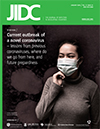2019-nCoV (Wuhan virus), a novel Coronavirus: human-to-human transmission, travel-related cases, and vaccine readiness
DOI:
https://doi.org/10.3855/jidc.12425Keywords:
Wuhan, 2019-nCoV, coronavirus, human-to-human transmission, vaccine readinessAbstract
On 31 December 2019 the Wuhan Health Commission reported a cluster of atypical pneumonia cases that was linked to a wet market in the city of Wuhan, China. The first patients began experiencing symptoms of illness in mid-December 2019. Clinical isolates were found to contain a novel coronavirus with similarity to bat coronaviruses. As of 28 January 2020, there are in excess of 4,500 laboratory-confirmed cases, with > 100 known deaths. As with the SARS-CoV, infections in children appear to be rare. Travel-related cases have been confirmed in multiple countries and regions outside mainland China including Germany, France, Thailand, Japan, South Korea, Vietnam, Canada, and the United States, as well as Hong Kong and Taiwan. Domestically in China, the virus has also been noted in several cities and provinces with cases in all but one provinence. While zoonotic transmission appears to be the original source of infections, the most alarming development is that human-to-human transmission is now prevelant. Of particular concern is that many healthcare workers have been infected in the current epidemic. There are several critical clinical questions that need to be resolved, including how efficient is human-to-human transmission? What is the animal reservoir? Is there an intermediate animal reservoir? Do the vaccines generated to the SARS-CoV or MERS-CoV or their proteins offer protection against 2019-nCoV? We offer a research perspective on the next steps for the generation of vaccines. We also present data on the use of in silico docking in gaining insight into 2019-nCoV Spike-receptor binding to aid in therapeutic development. Diagnostic PCR protocols can be found at https://www.who.int/health-topics/coronavirus/laboratory-diagnostics-for-novel-coronavirus.
Downloads
Published
How to Cite
Issue
Section
License
Authors who publish with this journal agree to the following terms:
- Authors retain copyright and grant the journal right of first publication with the work simultaneously licensed under a Creative Commons Attribution License that allows others to share the work with an acknowledgement of the work's authorship and initial publication in this journal.
- Authors are able to enter into separate, additional contractual arrangements for the non-exclusive distribution of the journal's published version of the work (e.g., post it to an institutional repository or publish it in a book), with an acknowledgement of its initial publication in this journal.
- Authors are permitted and encouraged to post their work online (e.g., in institutional repositories or on their website) prior to and during the submission process, as it can lead to productive exchanges, as well as earlier and greater citation of published work (See The Effect of Open Access).








